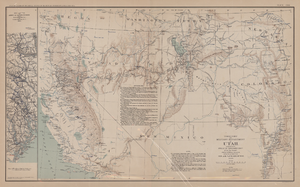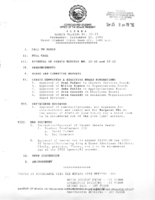Search the Special Collections and Archives Portal
Search Results

Transcript of interview with Rabbi Sanford Akselrad by Barbara Tabach, October 29, 2014
Date
Archival Collection
Description
Sanford Akselrad is the rabbi at Congregation Ner Tamid. In this interview he describes his rabbinical training, coming to Las Vegas, and the growth of the congregation.
More inclined in his youth to pursue a career as a scientist than rabbi, Sanford Akselrad (1957- ) became the rabbi at Congregation Ner Tamid in 1988. Turning his tenure, Rabbi Akselrad has lead the congregation through its move from Emerson to Street to its permanent home on Green Valley Parkway and I-215 and shares a fun story about buying desks and chairs from the Clark County School District. He talks about many of the milestones including: Project Ezra which he started during the 2008 recession to help Jewish community members find jobs; the NextGen program which was initiated to bring young adults in their twenties and thirties back to the temple. For over twenty years Rabbi Akselrad was a member of the board of the Nevada Governor?s Council on Holocaust education, a topic that was the focus of his rabbinical thesis. He was the founding president of the Clark County Board of Rabbis and has served on the boards of the Jewish Federation of Las Vegas, Jewish Family Services, and the Humana Hospital Pastoral Advisory Board. He was also the chair of the Federation?s Community Relations Council (CRC). Rabbi Akselrad is a board member of the Anti-Defamation League Nevada region office and the Interfaith Council of Southern Nevada. Sanford Akselrad was born on October 6, 1957 in Oakland, California and raised in Palo Alto. He attended the University of California, Los Angeles and then went to graduate school at the Hebrew Union College Jewish Institute of Religion. He spent the first year of his graduate program in Israel, the next two in Los Angeles, and the final two years in Cincinnati, Ohio. Rabbi Akselrad met his wife Joni in Reno, Nevada and married her during his third year of rabbinical school. The couple has two children, CJ and Sam. After his ordination in 1984, Rabbi Akselrad was associate rabbi of Temple Israel in Columbus, Ohio, one of the largest Reform congregations in the Midwest. His choice of career was inspired by his father, Sidney Akselrad, who was a prominent rabbi involved in social justice issues and the Civil Rights Movement. Sanford Akselrad has followed his father?s example of community involvement, both in Las Vegas and on a national level: he served on the board of the National Conference of Community and Justice (NCJJ), he was chair of the NCJJ's Inter-faith Council, and he is active in the Union of Reform Judaism (URJ).
Text

Interview with Robert Martin "Doc" Campbell, Jr., March 12, 2005
Date
Archival Collection
Description
Text

Interview with John Shannon Coogan, September 15, 2006
Date
Archival Collection
Description
Text

Transcript of interview with Jerome "Jerry" Jay Vallen by Lisa Gioia-Acres, October 2, 2007
Date
Archival Collection
Description
Text
Bezard, Pierre, 1924-2020
"Pierre was born June 16, 1924 in Paris, France. He survived WWII as a prisoner in a Nazi work camp where he met his lifelong friend Louis Juif. After the war, he returned to his family and began his career working backstage in theater. Although he never had much formal education, Pierre quickly ascended to the position of stage director, managing numerous productions including the Lido in Paris, Casino de Paris in Las Vegas, Ballet de Roland Petit, Solid Gold Las Vegas, Vive Les Girls, as well as touring shows worldwide.
Person
The Front Page, approximately 1927 to 1939
Level of Description
Scope and Contents
The Front Page sub-series (approximately 1927-1939) is comprised of materials pertaining to the production process of The Caddo Company's April 4, 1931 release of The Front Page. The sub-series contains advertising and publicity, administrative, financial, legal, and production and direction, and story development records. Director Lewis Milestone, along with editor Duncan Mansfield and writers Ben Hecht, Charles MacArthur, and Bartlett Cormack helped the film earn Academy Awards nominations for Best Director and Best Picture in 1929. The black-and-white photographic prints and negatives, primarily attributed to Newton Hopcroft, depict set and production stills of the principal and supporting cast and locations in the film.
Advertising and publicity records include newspaper clippings detailing the film’s release, articles of local advertising campaigns, and publicity stills of principal and supporting cast members. Administrative records include correspondence pertaining to the editing, censorship, and distribution of the film, as well as shipping receipts. Legal records include supporting actor and domestic distribution contracts. Production and direction records include production stills of principal and supporting cast, interior and exterior sets, and a sound and production daily report ledger. The story development records include production scripts, as well as cutting continuities and dialogue scripts for domestic and international releases.
Archival Collection
Collection Name: Howard Hughes Film Production Records
Box/Folder: N/A
Archival Component

Map of territory and military department of Utah, 1860
Date
Description
Image

Meeting minutes for Consolidated Student Senate University of Nevada, Las Vegas, September 30, 1992
Date
Archival Collection
Description
Text
